#Pietro Vannucci
Explore tagged Tumblr posts
Text

Pietro Vannucci (Italian, c.1446-1523) Ritratto di giovinetto, 1494 Uffizi Gallery Florence
#il Perugino#Pietro Vannucci#Ritratto di giovinetto#1400s#european art#italian art#mediterranean#southern europe#europe#oil painting#traditional art#black eyes#europa#giovinetto#1494
143 notes
·
View notes
Text
De link van mijn ' Arsenale delle Culture' met Piranesi, Escher, Jeroen Krabbé en Sean Connery
Hoe je van Toos van Holstein's installatie 'Arsenale delle Culture' in Perugia via haar labyrintische hersenspinsels bij Umberto Eco en Jeroen Krabbé komt? Laat je door beeld en woord leiden in deze blogaflevering van TOOS&ART. #kunst #art #expo
aan het tekenen in Perugia met op de achtergrond het beeld van Perugino Onder het toeziend oog van de grote Renaissance-kunstenaar Pietro Vannucci, beter bekend onder zijn bijnaam Perugino, komt tekeninspiratie natuurlijk als vanzelf. Net als gedachtenspinsels over een andere Italiaan: Piranesi. En associaties over ‘De Ontdekking van de Hemel’ en ‘De Naam van de Roos’. Films gemaakt naar…

View On WordPress
#bibliotheek#De ontdekking van de hemel#decor#Escher#filmregisseur#fort#Harry Mulisch#Hemel#internet#Jeroen Krabbé#klooster#Naam van de roos#Open Monumentendag#pakhuis#Perugia#Perugino#Pietro Vannucci#Piranesi#rijksmonument#Rocca Paolina#Sala Cannoniera#Sean Connery#Umberto Eco
1 note
·
View note
Text
Perugino. Rinascimento immortale
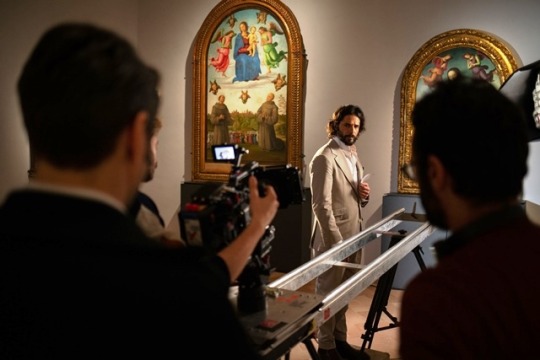
View On WordPress
0 notes
Text
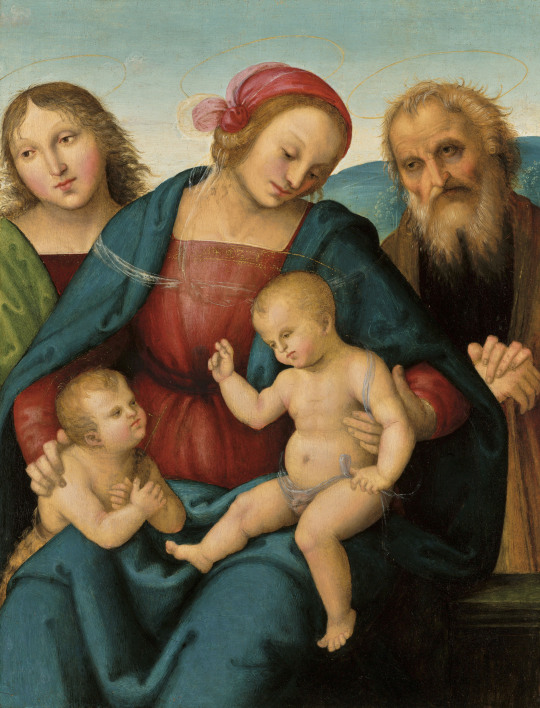
Pietro di Cristoforo Vannucci, called Perugino, The Holy Family with the Infant Saint John the Baptist and an Angel, date unknown
10 notes
·
View notes
Text

Saint Catherine of Alexandria
detail
Virgin and Child with Two Angels, and Saint Rose and Saint Catherine of Alexandria
Perugino (Pietro Vannucci) and workshop
oil on poplar
1490-1495
Louvre
257 notes
·
View notes
Photo

Le Pérugin
Pietro Perugino (dit Le Pérugin, c. 1450-1523), de son vrai nom Pietro di Cristoforo Vannucci, était un artiste italien de la Renaissance qui réalisa des fresques pour la chapelle Sixtine du Vatican et était demandé dans toute l'Italie pour décorer l'intérieur des églises et réaliser des portraits de la classe dirigeante. Le Pérugin cherchait très souvent à créer une impression d'espace dans ses œuvres, en particulier entre l'action principale au premier plan et des exemples d'architecture rendus avec précision à l'arrière-plan. L'utilisation de l'espace et de la perspective par l'artiste influença de nombreux artistes de la Renaissance qui le suivirent, notamment son ancien élève Raphaël (1483-1520).
Lire la suite...
2 notes
·
View notes
Text

Virgin and Child on the throne between Saint Jerome, Saint Augustine, four angels and two cherubs
Tempera and oil on wood - around 1500 / 1510
Le Pérugin (born Pietro di Cristoforo Vannucci - 1450-1523), Musée des Beaux-Arts, Bordeaux, Aquitaine, France.
#art#religious art#virgin mary#15th century art#painting#italian art#italian master#le pérugin#Perugino
4 notes
·
View notes
Text
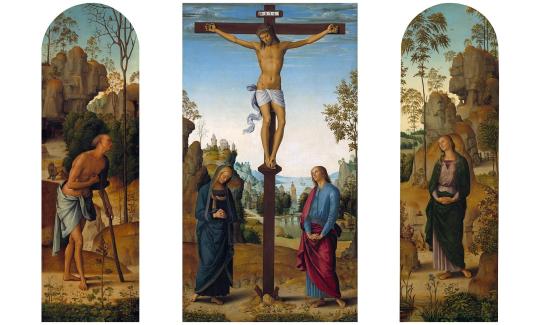
La crucifixión con la Virgen, San Juan, San Jerónimo y Santa María Magdalena, do. 1482/1485, de Pietro Perugino (Umbrian, c. 1450 – 1523), óleo sobre panel transferido a lona. Colección Andrew W. Mellon, National Gallery of Art.
Pietro Vannucci, llamado Perugino por la ciudad en la que vivió a menudo, colaboró con otros pintores famosos en una de las comisiones más prestigiosas de finales del siglo XV: la decoración de las paredes de la Capilla Sixtina en 1481-1482. Dirigió talleres activos en Perugia y Florencia, donde finalmente sería eclipsado por su mejor alumno, Rafael.
La Crucifixión de Perugino con los Santos, pintada para una capilla en la iglesia dominicana en San Gimignano, cerca de Siena, muestra a Cristo colgado en la cruz con María y San Juan Evangelista a sus pies. En los dos paneles laterales, san Jerónimo con su león y María Magdalena contemplan la figura de Cristo. Sin embargo, el trabajo no intenta representar el evento o lugar real, sino que es una meditación visual sobre el tema de la Crucifixión. El ambiente sereno se refleja en el paisaje, que también revela la influencia de la pintura flamenca que se había introducido recientemente en Florencia.
Desde finales del siglo XVII hasta principios del siglo XX, se pensaba que la Crucifixión de Perugino era obra de su alumno Rafael. Cuando se descubrió que el donante del tríptico murió en 1497, cuando Rafael tendría solo catorce años, la autoría de Perugino una vez más quedó clara.
2 notes
·
View notes
Text
"Perugino. Rinascimento immortale" al cinema solo il 3, 4 e 5 aprile
Il documentario, con la partecipazione straordinaria di Marco Bocci, racconta la vita e l’opera di Perugino partendo dal legame con la sua terra, l’Umbria, e in particolare con i paesaggi luminosi che si aprono sulle sponde del lago Trasimeno che spesso Perugino ha immortalato sullo sfondo dei suoi dipinti. Da Castel della Pieve, un borgo immerso in quei paesaggi, Pietro Vannucci, che solo in…

View On WordPress
2 notes
·
View notes
Text
Due capolavori del Perugino tornano in Italia
La Fondazione Perugia ha acquistato a un’asta viennese due opere del Perugino che da tempo erano in mano a un collezionista privato. Le due tavole, entrambe dipinte dall’artista su un fondale color nero bitume, hanno come soggetti il Cristo coronato di spine, realizzato tra il 1497 e il 1550, e la Vergine del 1500. Le opere sono un esempio della genialità del Pietro Vannucci. Entrambe le tavole…
#antonietta bandelloni#art#artblogger#arte#artinfluencer#bellezza#capolavoro#english#Michelangelo Buonarroti#museiemostre#rinascimento
0 notes
Text
Infiorata di San Luigi Gonzaga 2024 a Città della Pieve
L’Infiorata 2024 di Città della Pieve, in provincia di Perugia, in onore di San Luigi Gonzaga, giunti alla cinquantanovesima edizione, resta uno dei momenti più suggestivi proposti dal borgo dell’Umbria ai suoi visitatori. Sabato 22 e domenica 23 giugno, a cura del Terziere Casalino, un tappeto floreale di oltre 900 metri quadrati partirà da Porta Sant’Agostino, percorrerà Via Pietro Vannucci…

View On WordPress
0 notes
Text

Città della Pieve capolavoro di Pietro Vannucci 1504 Perugino “ADORAZIONE DEI RE MAGI”
0 notes
Text

THE ENIGMA OF THE MASTER OF SAINT FRANCIS - The Stil Novo in Thirteenth-Century Umbria
Perugia, National Gallery of Umbria (Corso Pietro Vannucci, 19)
10 March – 9 June 2024
For the first time, sixty masterpieces reveal the secrets of the most important artist to have worked in Central Italy after Giunta Pisano and before Cimabue. The exhibition is being held in the framework of the celebrations marking the eighth centennial of the appearance of the stigmata on Saint Francis of Assisi.
Following the record-breaking exhibition dedicated to Perugino in 2023, from 10 March to 9 June 2024 the National Gallery of Umbria in Perugia will host another prestigious undertaking, introducing the general public to the figure of the Master of Saint Francis, one of the most important artists of the thirteenth century after Giunta Pisano and before Cimabue.
Curated da Andrea De Marchi, Veruska Picchiarelli and Emanuele Zappasodi as part of the celebrations marking the 800th anniversary of the appearance of the stigmata on the body of Saint Francis of Assisi, this exhibition brings together for the first time 60 masterpieces from some of the world’s most prestigious museums, from the Louvre in Paris and the National Gallery in London to the Metropolitan Museum in New York and the National Gallery of Art in Washington.
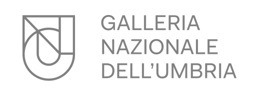
From the National Gallery of Umbria, which holds the most substantial nucleus of the works on panel by the Master of Saint Francis, the exhibition extends ideally to feature the cycle of Stories from the Life of Christ and Stories of Saint Francis painted by the artist in the Lower Basilica of Saint Francis in Assisi, one of the consequences of the agreement of valorisation concluded between the Franciscan friary of the Sacro Convento and the museum in Perugia.
The thirteenth was a century of enormous social, economic and cultural upheavals. Umbria was to prove itself the region that was best capable of absorbing and developing on the religious and cultural revolution generated by the birth of the mendicant orders, in particular the Franciscans, transforming it into positive energy. Umbria and Assisi, where some of the most singular works of the art of the age were created, became the new fulcrum in the system of European arts, where the mysterious figure emerged of the Master of Saint Francis, to whom scholars are still incapable of giving a name. Indeed, this is why he is known after the panel with the effigy of Saint Francis painted on the same board on which tradition tells us that the saint passed away, now preserved in the Museum of the Porziuncola at the church of Santa Maria degli Angeli, in Assisi, and exceptionally on show in the exhibition in Perugia.
It was to him that the friars minor turned, first to work on the stained glass in the Upper Basilica, flanking the master craftsmen from Germany and France, then to decorate the entire Lower Basilica. Creating myriad different friezes, in imitation of enamels and the fine work of goldsmiths, the Master set the first cycle of Stories of the Life of Saint Francis in the basilica’s single nave, telling them in parallel with those of the Life of Christ, as specified by Bonaventura da Bagnoregio, then the General of the Order: for the first time, the saint was identified as Alter Christus, a man whose similarity to Christ himself also extended to his body, with the gift of the stigmata.
Employing relief scans made using 3D lasers for the occasion, the exhibition will include an immersive room using new technologies to reconstruct the mural paintings by the Master in the Lower Basilica in Assisi, some of which suffered as a result of subsequent work executed at the end of the thirteenth century, in particular after the arrival of Giotto.
The exhibition will hinge around the Crucifix, dated 1272 and coming from the church of San Francesco al Prato in Perugia, one of the most important pieces of all the works housed in the Gallery, providing a focus for the majority of the painter’s works, which are returning to Umbria from various museums all over the world. A climate-controlled showcase will house the surviving section of the double-sided reredos that used rise above the high altar in the church of San Francesco al Prato, visually completing the great Crucifix, of which the National Gallery of Umbria now houses the largest number of fragments.
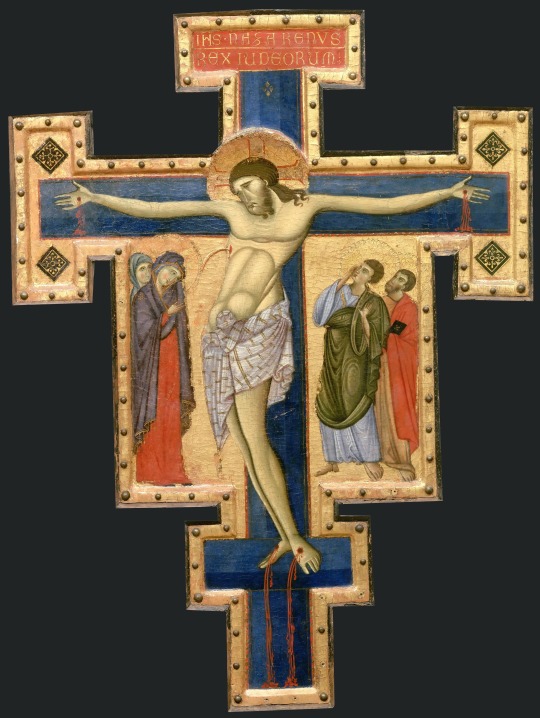
The exhibition will also attempt to furnish an articulated and as systematic as possible documentation of all painting produced in Umbria in the period when the Master of Saint Francis was active, from the middle of the century to the inauguration of the project to adorn the Upper Basilica of Assisi under Pope Nicholas IV. The symbolic starting point will in any case be the work in Umbria of Giunta Pisano, attributing the new, later dating of approximately 1230 to the reredos with Saint Francis of Assisi and the Four Post-Mortem Miracles from the Museum of the Treasury of the Pontifical Basilica of Saint Francis in Assisi, one of the century’s masterpieces, and comparing it with the other version now in the Vatican Museums and with the signed Crucifix of the Porziuncola. Of no less significance is the possibility to appreciate the works probably by Gilio di Pietro from Pisa, who was active in Siena and Orte in the middle of the century.
Alongside the Master of Saint Francis, reconstructions will also be ventured of some of his contemporaries, such as the Master of the Franciscan Crucifixes and the Master of Santa Chiara, the latter case made possible by the exceptional loan of the hagiographic altarpiece from the Basilica of Saint Clare, dated 1283, and of the monumental painted crucifix from the Rocca Flea Civic Museum in Gualdo Tadino. The production of the Master of the Marzolini Triptych, which has some singular affinities with Armenian miniature painting, will provide eloquent evidence of the extraordinary polyphony of works and of artists in Umbria in the second half of the thirteenth century, grown to maturity in the shadow of the international construction project in Assisi.
The region unquestionably constitutes a privileged observatory for understanding the nature of the intense exchanges that criss-crossed the Mediterranean trading routes in that period, between the Holy Land and central Italy, the cradle of the Franciscan movement, and of the epoch-making artistic revolutions that would have been inconceivable in the absence of the climate created in the Basilica of Saint Francis.
The exhibition is the result of a partnership between the National Gallery of Umbria, the Ministry of Culture, the Pontifical Basilica and Franciscan Friary of the Sacro Convento of Saint Francis in Assisi and the “San Francesco d’Assisi” Seraphic Province of the Friars Minor of Umbria, with the support of the Perugia Foundation and in synergy with the Region of Umbria.
The Enigma of the Master of Saint Francis. The Stil Novo in Thirteenth-Century Umbria
Perugia, National Gallery of Umbria (Corso Pietro Vannucci, 19)
10 March – 9 June 2024
Edwin Alexander Francis is the audioguide narrator. Produced by OrpheoGroup. Recorded at StudioColosseo, Rome
0 notes
Link
La vita di Pietro Vannucci in un fumetto, ecco l'opera collettiva “Chiuso, rustico, di poche parole. Eppure dietro la scorza dura c'è un tipo vero, schietto e romantico, a cui piacciono le cose belle e fatte bene”. U...
0 notes
Text
Il Perugino, pittore di capolavori
Pietro Vannucci
di Paolo Battaglia La Terra Borgese La formazione artistica di PietroIl capacissimo pittore italiano rinascimentale Pietro di Cristoforo Vannucci,detto il Perugino (Città della Pieve, Perugia, 1450 ca – Fontignano, Perugia,1523), si formò a due grandi scuole – quella, indiretta, di Piero della Francesca,che il Perugino conobbe attraverso le sue opere maggiori sparse fra Umbria,Marche e Toscana,…

Visualizza su WordPress
0 notes